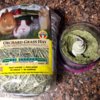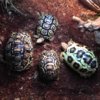I've been grinding up orchard grass hay in a small food processor and sprinkling the dry grass bits over the greens I feed my leopards.


My questions are, how much grass/hay is optimal in their diet? And Do leopards ever get to a point that they will eat soft dry hay? I'd prefer to feed fresh grass and do put Bermuda clippings in their food on occasion but they don't seem to eat much of it. It's possible I didn't make it small enough to make eating it from a dish acceptable for them. They will eat a little grass while outside but the much prefer leafy greens and weeds over any sort of grass.
But they do eat the ground up hay when it is wet and sticking to their other greens. They probably wouldn't touch it if it was just a big pile of wet hay but I their greens they don't appear to avoid it.


My questions are, how much grass/hay is optimal in their diet? And Do leopards ever get to a point that they will eat soft dry hay? I'd prefer to feed fresh grass and do put Bermuda clippings in their food on occasion but they don't seem to eat much of it. It's possible I didn't make it small enough to make eating it from a dish acceptable for them. They will eat a little grass while outside but the much prefer leafy greens and weeds over any sort of grass.
But they do eat the ground up hay when it is wet and sticking to their other greens. They probably wouldn't touch it if it was just a big pile of wet hay but I their greens they don't appear to avoid it.



















